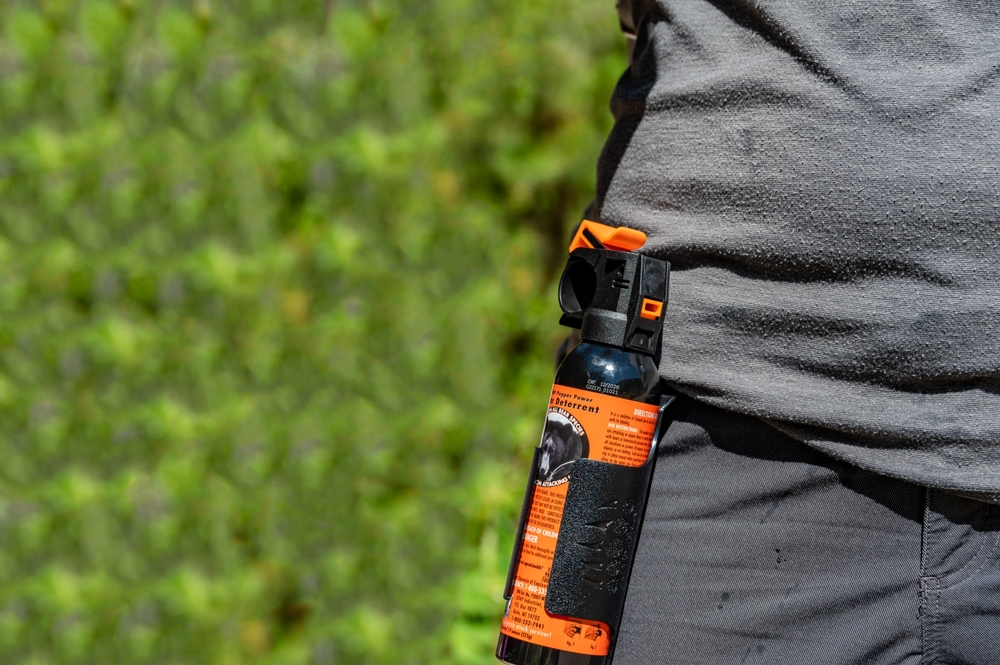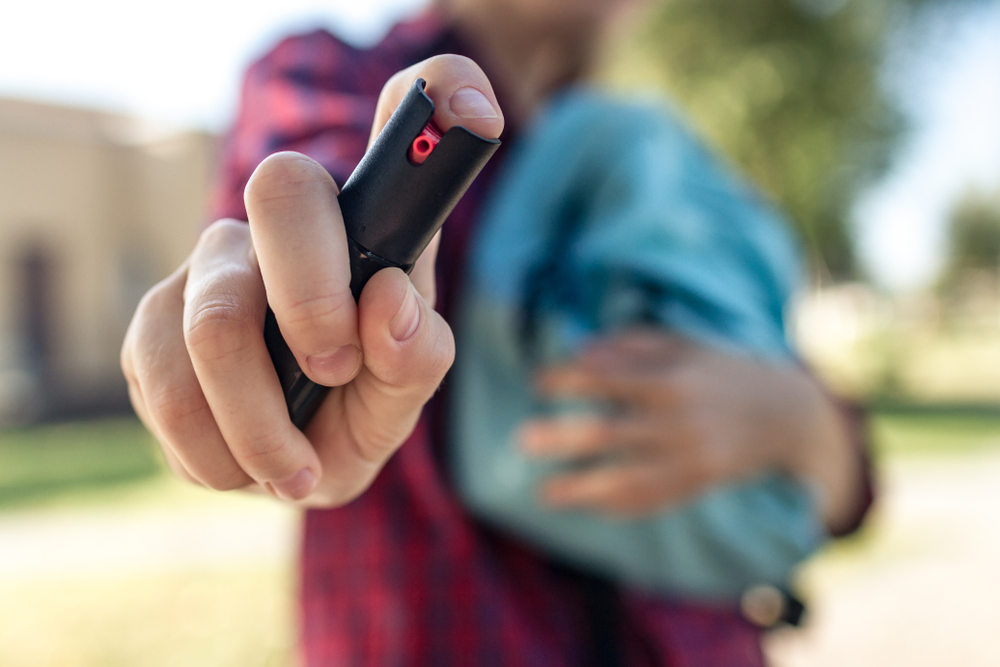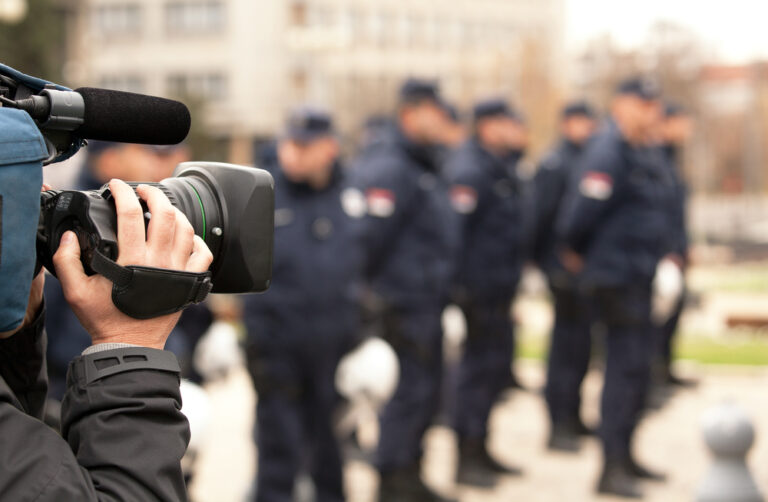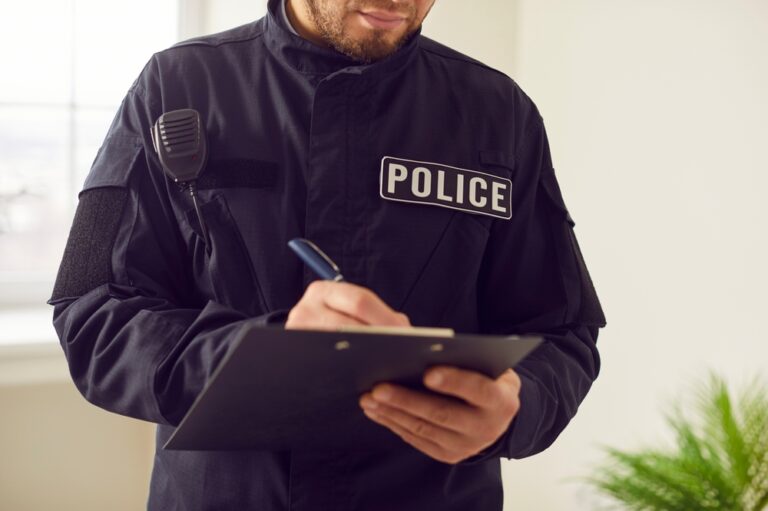
Police Tape 101: Everything You Need to Know
Police tape, commonly known as crime scene tape, is an important tool used by law enforcement to secure…

It’s more common than you’d think for people to consider buying bear spray vs pepper spray as a self-defense weapon.
Although both are designed to deter predators and attackers, they are quite different in formulation and effectiveness.
Knowing the considerable differences between a bear deterrent spray and a personal protection pepper spray could make a huge difference in your overall safety.
If you’ve ever considered camping, you’ve likely heard of or seen animal spray in the camping aisle of your local store.
It’s a unique self-defense weapon that protects you against aggressive bears before contact.
In formulation, the active ingredient is similar to that of pepper spray except for one major tenet: the concentration of the formula.
Interestingly, bear repellent is developed to be a humane option to help protect you from attacks by bears.
The active ingredient can also deter other aggressive animals, such as dogs and coyotes.
With that said, the concentration of the formula is significantly less than that of personal protection pepper spray, making it a humane option.

Pepper sprays are crafted using the same ingredient as a bear spray canister, OC (Oleoresin Capsicum).
Oleoresin Capsicum is an oily substance extracted from cayenne peppers.
When sprayed in a person’s face, it can cause significant visual and respiratory distress, warding off attackers.
That said, pepper spray is often looked at as a non-lethal alternative to traditional weapons.
It is not formulated to maim the attacker but instead incapacitates them so that you can put distance between you and the aggressor.
As a law enforcement officer, it can also be an essential tool to help us lawfully arrest a human threat with less resistance than normal.

There are several key differences between bear and human defense sprays to consider.
As with any personal defense weapon, you must purchase the right product for the job.
For example, you wouldn’t want to get caught using expensive bear spray on a human, as it won’t have as many irritating effects.
Let’s explore some of the most common differences you’re bound to experience between a bear and standard pepper spray.
The most considerable difference between these two formulas is the concentration of Oleoresin Capsicum in the bottle.
This is particularly true if you live in Canada and the United States, as the formulation is strictly regulated.
In the United States, bear spray is strongly regulated by the EPA (Environmental Protection Agency) and cannot have a concentration of about two percent.
On the other hand, Canada requires bear spray manufacturers to produce ones with Capsaicin levels below one percent.
Compared to standard pepper spray, the concentration can be between three and four percent.
These figures alone show you how much more potent a human version of the spray is than what you would use on an attacking bear.
Another significant thing to consider before purchasing bear or defense pepper spray is their legality.
Again, this issue is most pressing in countries outside the U.S., as pepper spray is legal in most states.
In Canada, as an example, carrying defense spray is illegal based on the Criminal Code.
However, if you’re going camping, you can purchase animal spray to keep you protected.
If you’re caught carrying bear defense products outside of camping, you could also get in legal trouble.
Any self-defense weapons carried in public could be cause for prosecution.
As law enforcement officers, the last thing we want is to have a giant can of bear spray clipped to our belts.
This difference is important to note, as defense pepper spray is often designed to be small and concealable.
You’ll be able to easily keep it on your person or in your gear bag for easy access.
On the other hand, bear spray has a considerably larger design, which doesn’t make it as portable.
You might also find it’s more challenging to use in indoor settings due to blowback.
Meanwhile, a high-quality pepper design is meant to be sprayed indoors or outdoors without harming yourself.
Aside from canister size, spray marketing is another considerable difference.
Even when compared to bug spray, bear and pepper spray look noticeably different.
Pepper spray will have specific warnings, as well as bear spray labels.
When shopping for defense sprays, ensure you look at bear spray labels.
You’ll want to ensure you’re choosing the right product for your trip to a national park, such as the bear-filled Katmai National Park.
Additionally, you’ll want to guarantee you’re buying quality bear sprays to offer optimal protection against an aggressive charging bear.
Imagine you’re in the bear country dealing with a frightening bear encounter.
The last thing you’d want is to be within grabbing distance, as you wouldn’t have much of a chance.
A bear deterrent spray is designed to be sprayed at a further distance than conventional self-defense pepper sprays.
With their large, conical-shaped output, bear spray can be sent at least 25 feet away, if not more.
When sprayed, a giant bear spray cloud puts a barrier between you and the aggressive bear.
To get close, the animal needs to traverse through the column of spray, making it a giant deterrent.
Pepper spray is designed quite differently, as the active ingredient in pepper spray is meant to be shot directly at the face of the assailant.
It shoots out in a direct line when you discharge pepper spray rather than creating a wide cloud of bear spray.
With this process, it can get into your attacker’s eyes, making it easier to hit a specific target.
Most pepper sprays won’t be as effective above 15 feet, so you’ll likely be in closer quarters.
Also, it may have a different texture, such as a gel-like consistency, making the spray easier to travel without blowback.
Another obvious difference between bear and pepper spray is their use.
As you can tell, bear spray is designed for encounters with bears and wild animals, while pepper spray works best with humans.
Pepper spray is specifically designed to incapacitate aggressors, causing burning in the eyes, mouth, throat, and mucous membranes.
Depending on the potency of the spray you choose, it can also cause temporary blindness.
This feature is essential for law enforcement as it helps diffuse a situation without using lethal force.
Bear spray is considerably different, as the ingredients in bear spray products are more of a deterrent than a defense tool.
When faced with a scared or angry bear, the last thing you want to do is instigate an attacking animal with a shot of pepper spray.
It’s hard to predict whether the animal will attack or rush away from being scared.
Instead, it creates a wide bear spray cloud, creating distance between you and the animal so you can get away safely.
It’s also important to note that bear spray isn’t designed to harm the animal.
It’s simply an option to ensure you don’t get injured due to coming across nature.
Now that you have a good idea of the differences between pepper and bear spray, it’s important to know how to use both effectively.
I have a few sure-fire tips that can help civilians and law enforcement ensure they’re using both tools to the best of their ability.
One of the most important things to remember with pepper spray is that it can help to protect you in sticky situations.
With that said, you want to ensure you’re keeping it as accessible as possible.
Some pepper sprays can be attached to your belt, while others can connect to your keychain.
If you opt for larger bottles of pepper spray, you can easily put them into your gear bag for when you need them most.
As long as you can grab the spray within seconds, it can become a valuable alternative to your firearm.
This same theory applies to bear spray, as it should also be easily accessible when you’re camping.
Ideally, you’ll want to find a bear spray that can fit comfortably into a waistband holster you can keep on your belt.
Alternatively, keep it in one of the accessible pockets on your hiking or patrol bag, such as the side pocket.
It’s imperative to be prepared in every situation, and as such, it’s important you first test your sprays before you need to use them.
You’ll want to learn how to effectively hold the canister so that it discharges away from you.
Also, you’ll need to know how much pressure the trigger or button needs to be sprayed effectively.
The more comfortable you are with using types of spray, the easier it will be to use when you need it most.
Also, you’ll know the perfect distance to be at when you’re hindering the aggressor, whether it be a human or a bear.
You can perfect your technique to be confident to discharge pepper or bear spray when needed, like a park ranger.
Interestingly, the potency of the ingredients in bear spray and pepper spray will weaken with time.
The first thing to do is check the expiry label to ensure you always have a fresh bottle in your law enforcement kit.
Most sprays last up to four years, so you shouldn’t need replacements too often.
There are several differences between bear spray vs pepper spray, especially regarding potency.
In situations with animals, bear spray is the humane option, while pepper spray is the ideal potency for humans.
Ensuring you’re prepared for any situation is important to protect yourself against aggressive animals and assailants.

Police tape, commonly known as crime scene tape, is an important tool used by law enforcement to secure…

The police are called daily regarding various incidents of public interest. It is our responsibility to provide the…

Many police officers experience terrible, traumatic events in the line of duty. A significant number of police officers…